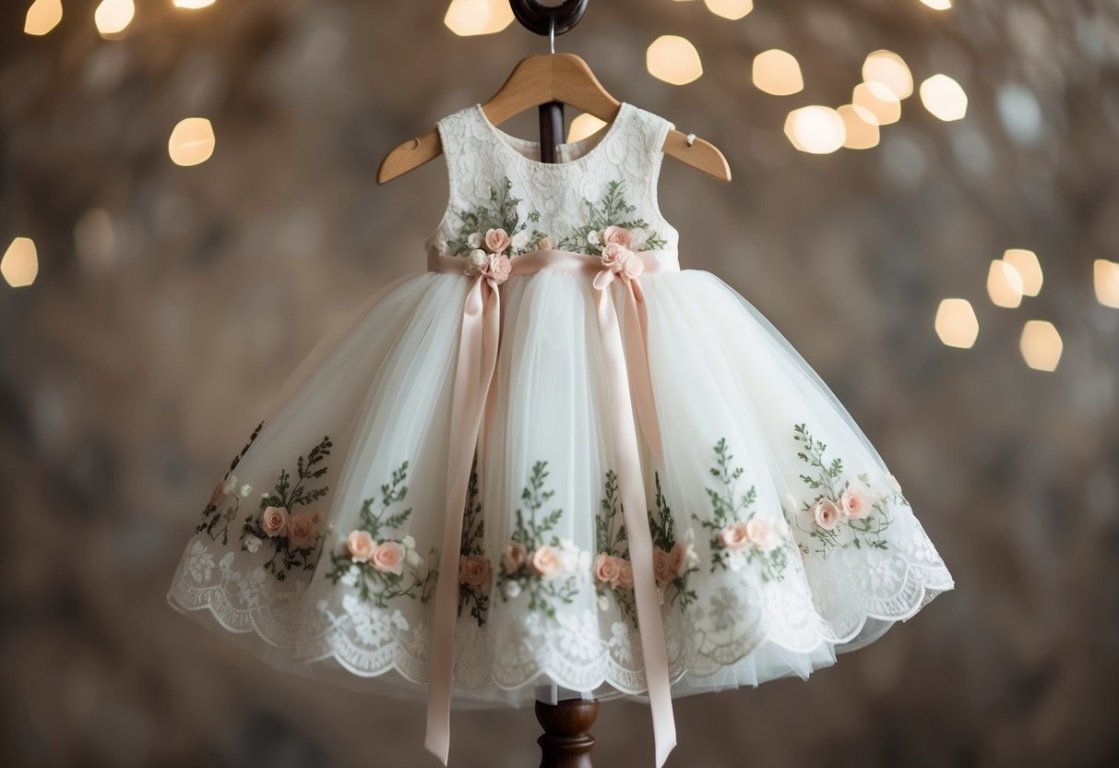The art of balancing delicate textures: Expert styling tips for breathtaking children’s ensembles that remain comfortable and age-appropriate
Kids’ fashion sparkles with endless possibilities when combining delicate fabrics like lace and tulle. These magical materials create enchanting outfits that balance style with comfort, letting children express their personality through clothing. Creating stunning outfits with lace and tulle is simple when you pair light, airy pieces with structured items like denim or cotton basics.
Mixing fancy blouses with casual pieces or pairing tulle skirts with simple t-shirts gives children’s outfits a playful yet polished look. This approach to styling makes fancy pieces more wearable for everyday activities while maintaining that special touch.
On This Page
Key Takeaways
- Lace and tulle combinations work best when balanced with simple, structured pieces
- Mixing casual and dressy items creates versatile outfits for various occasions
- Proper fabric choices ensure comfort whilst maintaining a stylish appearance
The Importance of Fabric Choice
Smart fabric choices create magical kids’ outfits that blend style with comfort. Lace and tulle combinations work together to make special occasion wear that children love to wear.
Lace Elegance in Kids’ Attire
Delicate lace fabrics add a refined touch to children’s special occasion wear. The intricate patterns and textures create visual interest while maintaining comfort.
When selecting lace for kids’ clothing, durability matters. Strong yarns woven into beautiful patterns ensure the garment stands up to active wear.
White and ivory laces suit formal events, while coloured laces bring playfulness to party dresses. Modern fashion trends embrace mixing different lace patterns in a single outfit.
Tulle’s Whimsical Charm
Tulle adds volume and movement to children’s fancy dress. Its lightweight nature makes it perfect for twirling and dancing.
Layering different colours of tulle creates depth and dimension. A pink dress might feature layers of white, blush, and rose tulle for a magical effect.
The fabric’s versatility allows for unique styling options. Designers often pair structured tulle skirts with soft lace bodices for a balanced look.
Pro tip: Choose softer tulle variants for children’s wear to prevent skin irritation.
Understanding Colour and Pattern Coordination
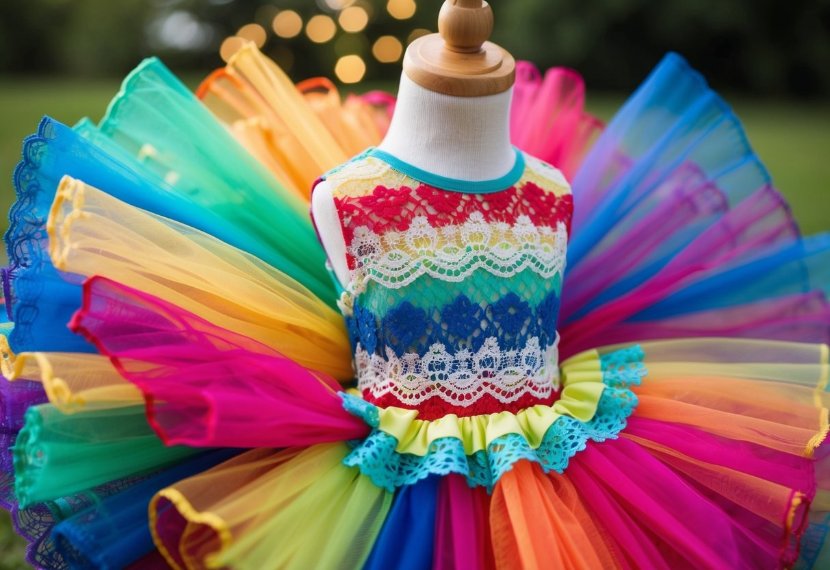
Mixing colours and patterns in children’s fashion requires knowledge of basic colour theory and pattern combinations. Strategic pairing creates visually appealing outfits that maintain a balanced, cohesive look.
The Colour Wheel Basics
The colour wheel serves as a vital tool for creating harmonious outfits. Primary colours (red, blue, yellow) form the foundation, while secondary colours emerge from their combinations.
Complementary colours sit opposite each other on the wheel, creating bold contrasts perfect for statement pieces. A purple tulle skirt pairs brilliantly with yellow lace accents.
Analogous colours sit next to each other, offering subtle transitions. Pink, purple, and blue create gentle flows in layered dresses.
Mixing Patterns with Precision
Playful pattern combinations work best when varying in scale. Large floral prints match well with small polka dots or delicate stripes.
Pattern mixing guidelines:
- Pair bold patterns with subtle ones
- Match colours within different patterns
- Keep one pattern as the focal point
- Limit combinations to 2-3 patterns per outfit
Animal prints act as neutrals when paired with geometric patterns. A leopard print belt can accent a dress with checked fabric.
Stripes and florals create classic combinations. A striped lace top coordinates beautifully with a floral tulle skirt when sharing a colour palette.
Contemporary Trends in Kids’ Fashion
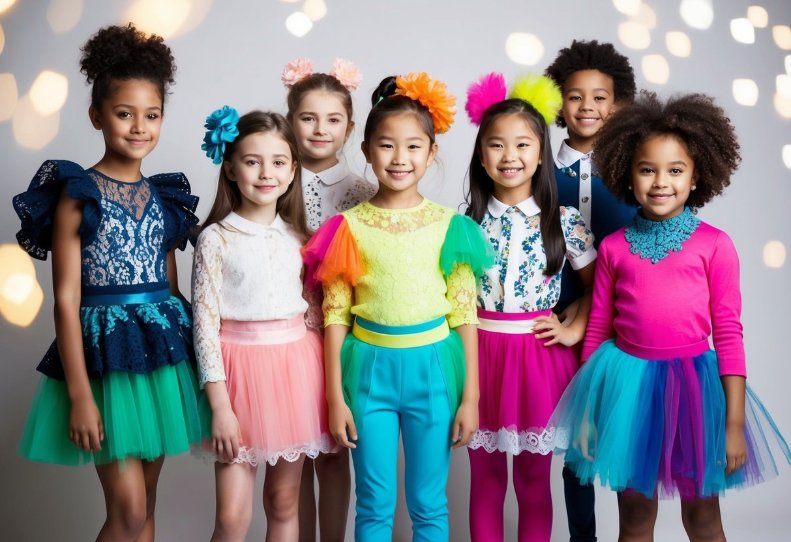
Young fashion enthusiasts are embracing the mix of classic patterns with fresh colour palettes in 2025. The fusion of traditional and modern elements creates versatile looks perfect for children’s wardrobes.
Current Favourite Patterns
Vintage-inspired designs remain strong, with plaid and floral prints leading the way. Bold geometric shapes add playful elements to everyday wear.
Children’s fashion now features oversized stripes paired with delicate details. These patterns work brilliantly with both casual and dressy pieces.
Popular Pattern Combinations:
- Floral prints with subtle polka dots
- Traditional plaid with modern geometric shapes
- Classic stripes with whimsical butterfly motifs
Influence of Seasonal Colours
Soft pastel shades dominate spring and summer collections. Mint green, lavender, and baby blue create gentle, appealing combinations.
These lighter tones pair wonderfully with tulle and lace details, adding depth to children’s outfits.
Key Colour Trends:
- Spring: Peach and mint green combinations
- Summer: Lavender with baby blue accents
- Autumn: Muted plaids with pastel highlights
The mix of bright and soft colours allows for creative layering. Pink and mint green create particularly striking combinations when used with lace elements.
Adapting Adult Fashion for Younger Audiences
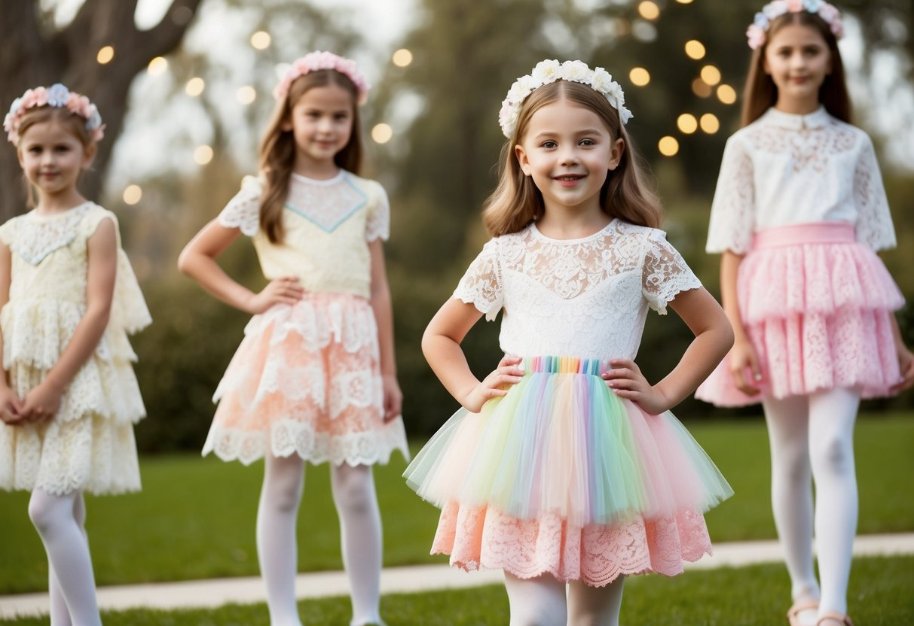
Fashion trends for children now mirror adult styles while maintaining age-appropriate elements. Major fashion houses create specialised children’s lines that blend sophistication with playful elements.
Inspiration from Formal Adult Wear
Tulle dresses and skirts translate beautifully from adult fashion to children’s formal wear. These pieces add whimsy and movement perfect for special occasions.
Designers adapt formal elements by:
- Using softer fabrics and elastic waistbands
- Adding playful embellishments
- Incorporating comfortable linings
- Choosing child-friendly closures
Young ones can express their personality through formal wear whilst maintaining comfort. A structured dress becomes more wearable with stretchy panels, whilst maintaining its elegant appearance.
Casual Trends Redefined for Children
Rock-inspired fashion elements work brilliantly in children’s casual wear when softened appropriately. A denim jacket paired with lace details creates a balanced look.
Casual adaptations focus on:
- Durable materials that withstand active play
- Easy-to-wear designs
- Mix-and-match possibilities
- Room for growth
Creative styling allows children to explore their individuality through fashion. Simple additions like removable patches or reversible elements make pieces more versatile and fun to wear.
Layering Techniques with Lace and Tulle
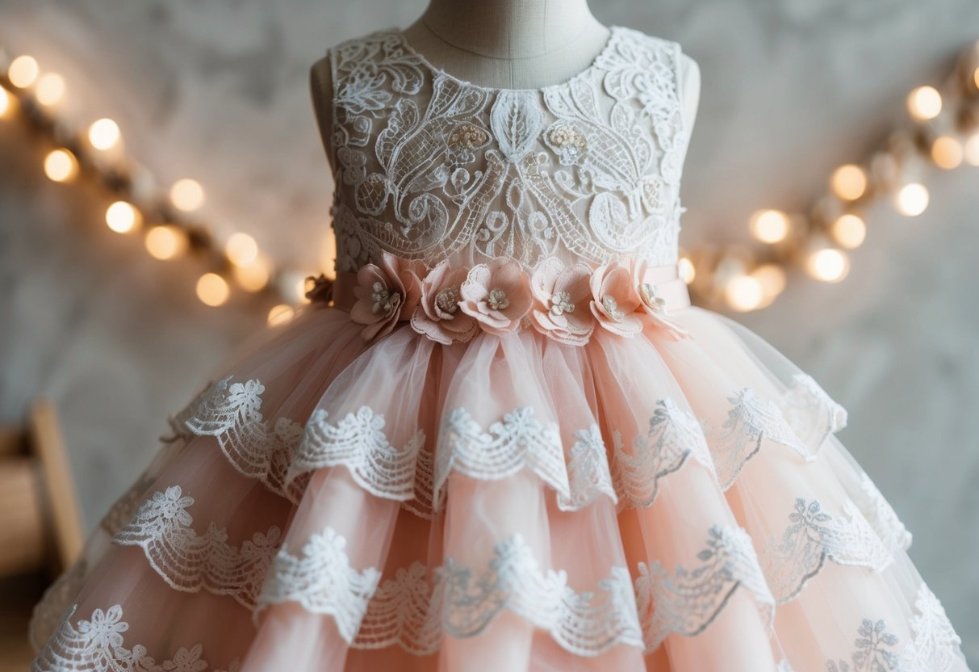
Combining lace and tulle creates magical looks for children’s special occasions whilst maintaining comfort and practicality. These fabrics work together to add dimension and personality to any outfit.
Balancing Textures for Comfort
Start with lightweight base layers that sit close to the skin. A soft cotton slip or bodysuit provides the perfect foundation.
Layer thin tulle over delicate lace to create airy, breathable combinations. The placement of lace details works best along hems and necklines where it won’t irritate sensitive skin.
Mix different weights of tulle to build interest without bulk. A medium-weight tulle base with a lighter overlay allows movement whilst maintaining structure.
Creating Voluminous and Structured Looks
Multiple layers of tulle create fullness in skirts and dresses. Start with 3-4 layers for everyday wear, adding more for special occasions.
Strategic placement of lace panels adds visual interest and breaks up large tulle sections. Place stiffer tulle underneath for support and softer layers on top for movement.
Pro tip: Alternate tulle types between layers:
- Bottom layer: Stiff tulle for structure
- Middle layer: Medium-weight for volume
- Top layer: Soft tulle for flow
Accessorising Lace and Tulle Outfits
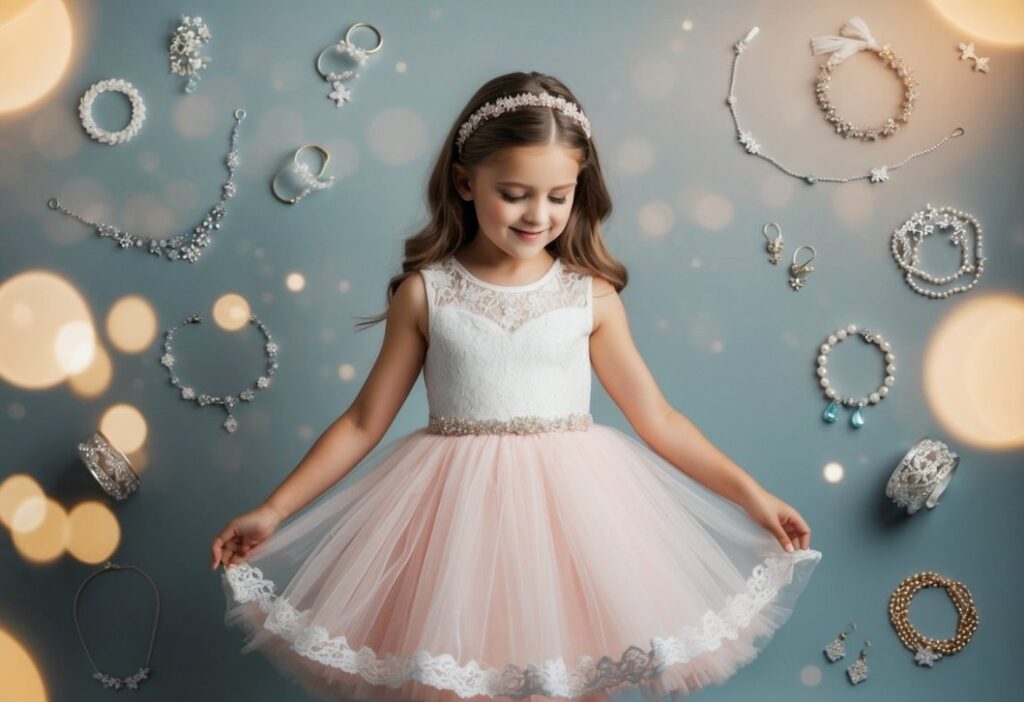
The right accessories transform lace and tulle children’s outfits from simple to spectacular. A thoughtful mix of complementary pieces enhances these delicate fabrics while maintaining comfort and practicality.
Matching Accessories with Complex Patterns
Adding belts to lace dresses creates shape and adds a playful touch. Choose thin fabric belts in solid colours that complement the dress pattern.
Hair accessories should complement rather than compete with the outfit’s patterns. Simple satin headbands work beautifully with floral lace, while pearl clips pair perfectly with classic white tulle.
When mixing patterns, stick to one bold element. If the dress features intricate lace patterns, opt for simple, solid-coloured accessories. For plain tulle skirts, decorative accessories with small floral or animal prints add visual interest.
Footwear and Outerwear Considerations
Kids’ boots and shoes need to be both practical and stylish. Ballet flats or mary janes in metallic or patent finishes complement formal lace outfits beautifully.
For cooler weather, layer with soft cardigans or lightweight jackets. Choose solid colours that match the undertones of the lace or tulle to create a cohesive look.
Tights or socks should be simple when worn with patterned lace. White or cream-coloured options work best, while textured tights pair nicely with plain tulle skirts.
Encouraging Creativity in Kids’ Personal Style
Fashion choices help children develop confidence and discover their unique identities through clothing. Kids who experiment with style learn valuable lessons about self-expression and artistic creativity.
Fostering Individual Expressions of Style
Children thrive when given freedom to explore different styles and make their own fashion choices. Let them select pieces that spark joy and reflect their personalities.
Gentle guidance works better than strict rules. Parents can teach basic colour coordination while still allowing room for creative interpretation.
Ways to Support Style Exploration:
- Organise dress-up sessions with various textures and accessories
- Create a designated space for them to plan outfits
- Celebrate unique combinations they create
- Ask questions about their style choices rather than criticising
Embracing Unorthodox Combinations
Mixing unexpected patterns and textures helps develop artistic confidence. Children often create surprisingly sophisticated combinations when given creative freedom with their wardrobe.
Encourage playful experimentation with:
- Layering different fabrics
- Mixing bold patterns
- Combining casual and dressy pieces
- Adding unexpected accessories
When children pair lace with tulle in unconventional ways, they learn to think creatively about fashion. These experiments help develop their unique style voice.
Frequently Asked Questions
Combining lace and tulle requires specific techniques, proper care methods, and careful attention to detail. Parents and fashion enthusiasts often seek guidance on creating beautiful outfits that blend these delicate fabrics whilst maintaining durability for active children.
How can one incorporate a tulle skirt into a child’s lace dress ensemble?
A tulle skirt creates magical volume when layered beneath a lace dress. Creating a child’s dress with tulle works best when using 2-3 layers of tulle beneath a lace overlay.
The tulle should be slightly longer than the lace layer to create a dreamy, floating effect.
What are the best methods for preventing tulle from fraying when trimming to desired lengths?
Heat-sealing the edges with a small flame prevents fraying effectively. Always test on a small piece first.
Using pinking shears creates a zigzag edge that reduces fraying, whilst clear nail polish can seal raw edges.
Are there any current trends in children’s fashion that combine lace and tulle?
Modern children’s fashion embraces layered designs with lace bodices and tulle skirts.
Pastel colours dominate the trend, with white lace overlays on coloured tulle being particularly popular.
Which types of undergarments are suitable for a child’s lace dress with a tulle overlay?
Cotton slip dresses or camisoles provide comfort against the skin. A simple cotton underskirt prevents itching from tulle layers.
What techniques ensure a tasteful blend of patterns when mixing lace and tulle in children’s clothing?
Matching the scale of lace patterns to the dress size creates balanced proportions. Small, delicate lace patterns work best for younger children.
Using solid-coloured tulle beneath patterned lace prevents visual confusion.
How can you maintain the quality of lace and tulle garments when washing and caring for children’s clothes?
Hand washing in cool water with mild soap preserves fabric integrity. Lay garments flat to dry, avoiding direct sunlight.
Store dresses hanging up to prevent crushing of tulle layers.

